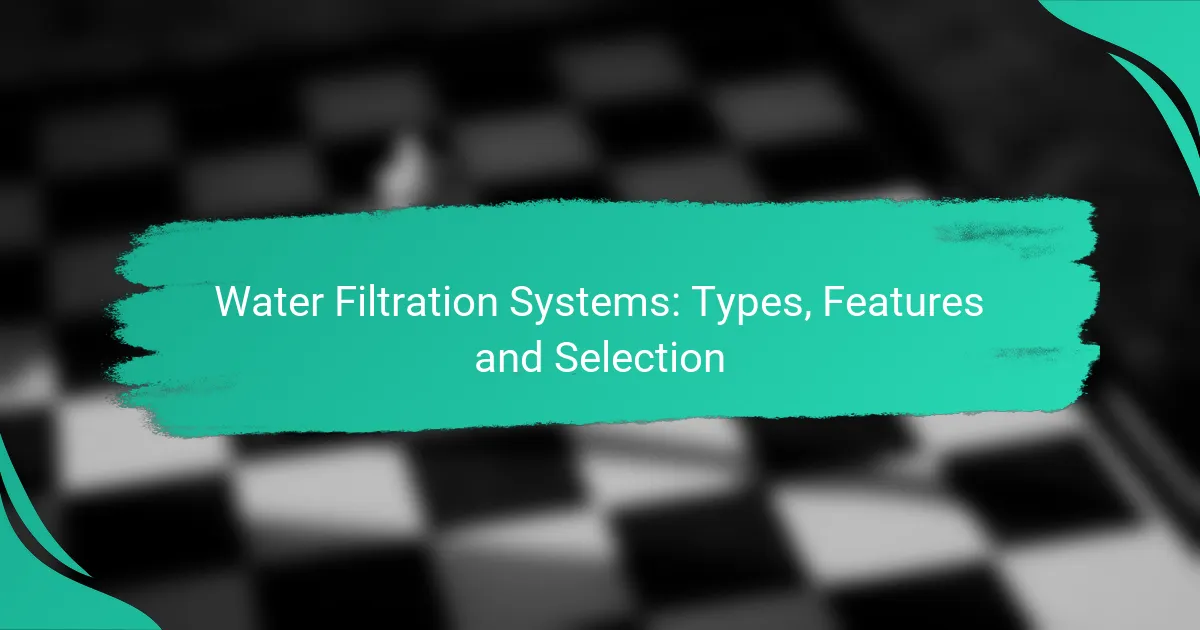Water filtration systems are essential for ensuring safe and clean drinking water by effectively removing contaminants and improving taste. With various options available, including reverse osmosis, activated carbon filters, and UV purification, each system offers unique features tailored to different needs. When choosing a filtration system, it’s important to consider factors such as flow rate, filter lifespan, and maintenance requirements to ensure optimal performance and usability.
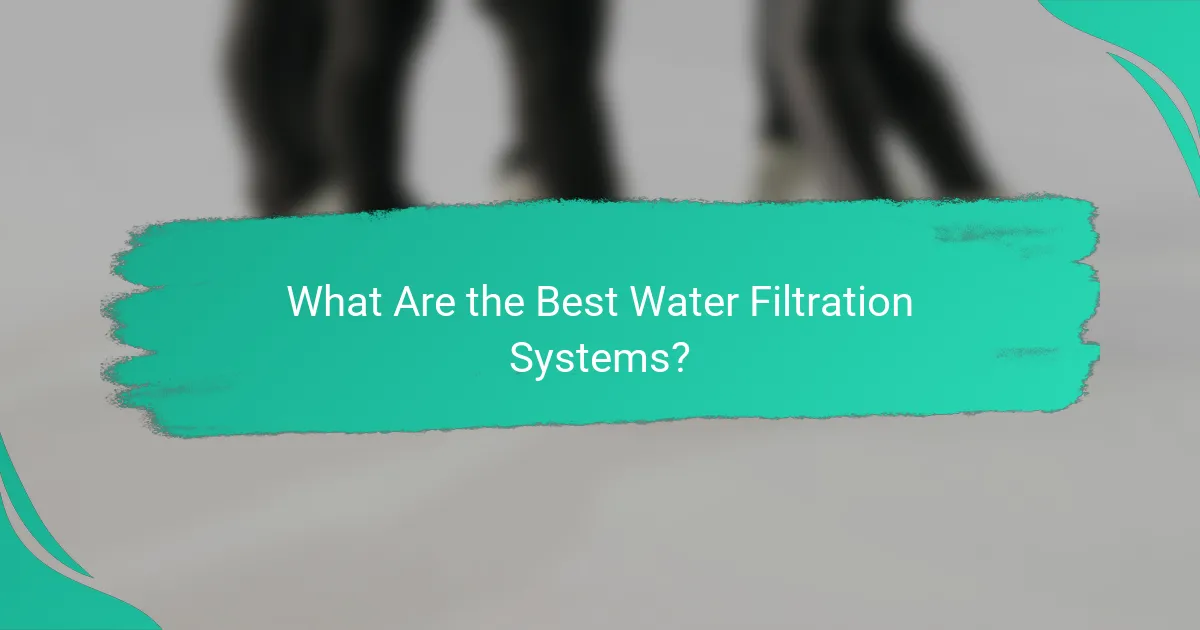
What Are the Best Water Filtration Systems?
The best water filtration systems effectively remove contaminants, improve taste, and ensure safe drinking water. Key options include reverse osmosis, activated carbon filters, UV purification, whole house systems, and pitcher filters, each with distinct features and benefits.
Reverse Osmosis Systems
Reverse osmosis (RO) systems are highly effective at removing a wide range of contaminants, including heavy metals, salts, and microorganisms. They work by pushing water through a semi-permeable membrane, allowing only clean water to pass while trapping impurities.
When selecting an RO system, consider factors such as the system’s capacity, the number of filtration stages, and the replacement filter costs. Many systems can produce several gallons of purified water per day, making them suitable for households with higher water demands.
Activated Carbon Filters
Activated carbon filters are popular for their ability to improve taste and remove chlorine, volatile organic compounds (VOCs), and some heavy metals. These filters use a porous carbon medium that adsorbs impurities as water passes through.
While effective for many contaminants, activated carbon filters do not remove all pathogens or dissolved minerals. Regular replacement is necessary, typically every few months, to maintain filtration efficiency. They are often used in point-of-use systems like faucet-mounted filters or under-sink units.
UV Purification Systems
UV purification systems use ultraviolet light to kill bacteria, viruses, and other pathogens in water. This method is chemical-free and does not alter the taste or odor of water, making it a safe choice for disinfection.
UV systems are best used in conjunction with other filtration methods, as they do not remove physical contaminants or chemicals. Ensure the system is properly sized for your household’s water flow rate and that the UV lamp is replaced annually for optimal performance.
Whole House Filtration Systems
Whole house filtration systems treat all water entering a home, providing clean water for drinking, cooking, and bathing. These systems can include various filtration methods, such as sediment filters, activated carbon, and water softeners, depending on the specific needs of the household.
When choosing a whole house system, consider the size of your home, water usage, and the specific contaminants present in your water supply. Installation can be more complex and may require professional assistance, but the convenience of having filtered water throughout the home is a significant advantage.
Pitcher Filters
Pitcher filters are a convenient and affordable option for improving water quality. These portable units use activated carbon to reduce chlorine, sediment, and some heavy metals, making tap water taste better.
While pitcher filters are easy to use and require no installation, they have limited capacity and may not remove all contaminants. Regular filter changes are essential, typically every two months, to ensure effective filtration. They are ideal for individuals or small households with lower water consumption needs.
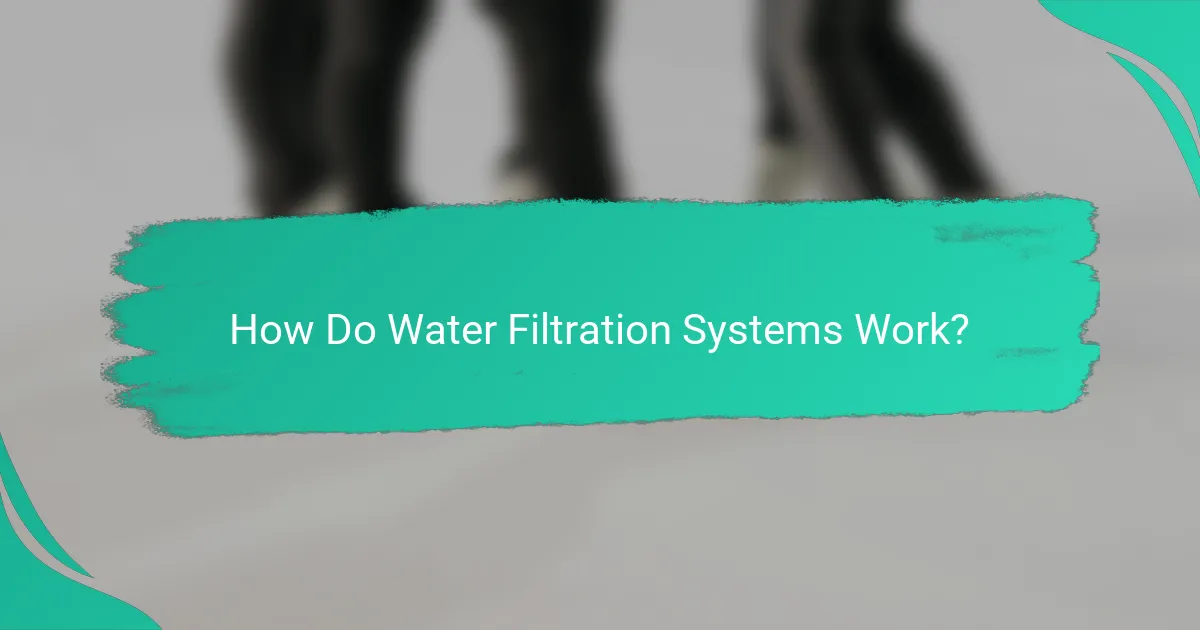
How Do Water Filtration Systems Work?
Water filtration systems work by removing impurities and contaminants from water, ensuring it is safe for consumption. These systems utilize various mechanisms and processes to achieve effective filtration, depending on the specific contaminants present in the water supply.
Filtration Mechanisms
Filtration mechanisms refer to the physical processes used to separate particles from water. Common methods include sedimentation, where larger particles settle at the bottom, and mechanical filtration, which uses barriers like screens or membranes to catch contaminants. Activated carbon filters are also popular, as they adsorb impurities through a chemical process.
Each mechanism has its strengths and weaknesses. For instance, mechanical filters can effectively remove larger particles but may not capture smaller contaminants like bacteria or viruses. Understanding the specific filtration mechanism helps in selecting the right system for your needs.
Contaminant Removal Processes
Contaminant removal processes vary based on the type of water filtration system. Common processes include reverse osmosis, which forces water through a semi-permeable membrane to remove dissolved solids, and UV treatment, which uses ultraviolet light to disinfect water by killing microorganisms.
When selecting a water filtration system, consider the contaminants present in your water supply. For example, if your water has high levels of chlorine or heavy metals, a system with activated carbon and reverse osmosis may be ideal. Always check for certifications, such as NSF/ANSI standards, to ensure the system effectively removes specific contaminants.

What Features Should You Consider?
When selecting a water filtration system, consider features such as flow rate, filter lifespan, installation requirements, and maintenance needs. These factors will significantly impact the system’s efficiency, cost-effectiveness, and overall usability in your home or business.
Flow Rate
Flow rate refers to the amount of water a filtration system can process in a given time, typically measured in gallons per minute (GPM). A higher flow rate is essential for households with multiple users or high water demand, ensuring that you have access to filtered water without long wait times.
When evaluating flow rates, look for systems that offer at least 2-5 GPM for average household needs. Keep in mind that higher flow rates may require more powerful pumps or larger filter systems, which can increase initial costs.
Filter Lifespan
The lifespan of a filter indicates how long it can effectively remove contaminants before needing replacement. Most filters last anywhere from six months to several years, depending on the type and usage. Regularly checking and replacing filters is crucial to maintain water quality.
Consider systems with filters that have longer lifespans, as they can save you money and reduce maintenance frequency. However, balance this with the initial cost of the filter, as longer-lasting options may be pricier upfront.
Installation Requirements
Installation requirements can vary significantly between different water filtration systems. Some systems are designed for easy DIY installation, while others may require professional help, especially those integrated into plumbing systems.
Before purchasing, assess your plumbing setup and determine if you have the necessary tools and skills for installation. Systems that are easier to install may save you additional costs, but ensure they meet your filtration needs effectively.
Maintenance Needs
Maintenance needs include regular filter changes, system cleaning, and occasional inspections to ensure optimal performance. Understanding these requirements can help you choose a system that fits your lifestyle and willingness to perform upkeep.
Look for systems that offer user-friendly maintenance options, such as filter indicators or easy access to components. Avoid systems that require extensive maintenance if you prefer a low-maintenance solution, as this can lead to neglect and reduced filtration efficiency over time.
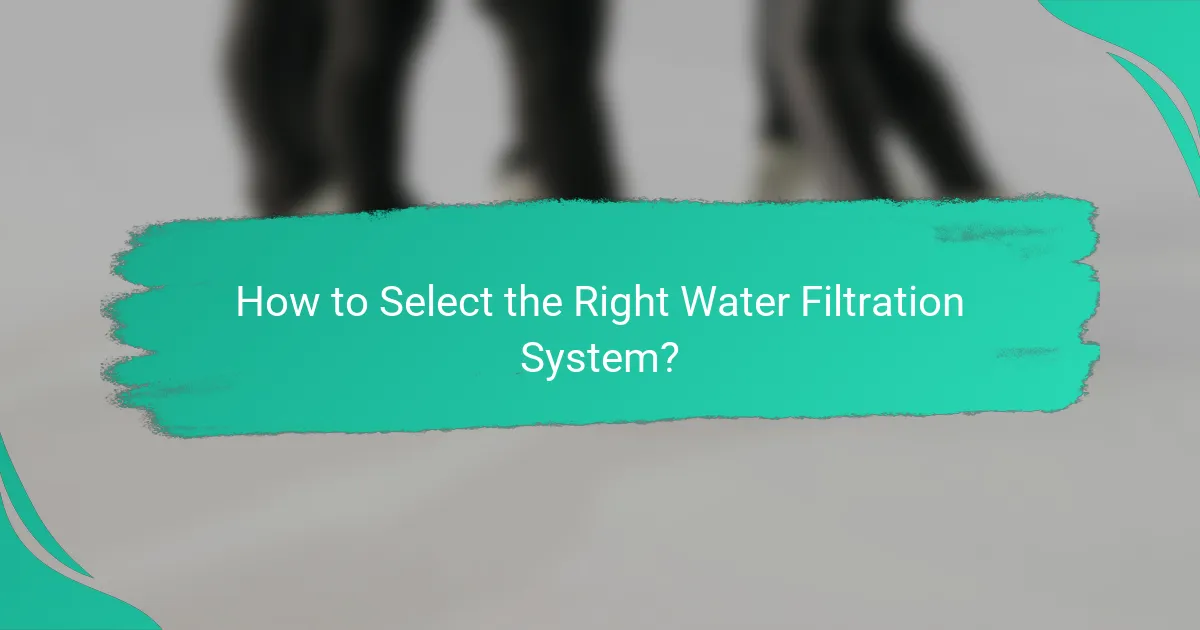
How to Select the Right Water Filtration System?
Selecting the right water filtration system involves understanding your water quality, identifying your household needs, and considering your budget. Each of these factors plays a crucial role in ensuring you choose a system that effectively meets your requirements.
Assessing Water Quality
Start by testing your water to determine its quality. You can use home testing kits or send samples to a lab for a more comprehensive analysis. Key contaminants to look for include chlorine, lead, bacteria, and hard minerals.
Understanding your water quality helps you select a filtration system that targets specific impurities. For example, if your water has high levels of chlorine, a carbon filter may be suitable, while a reverse osmosis system is better for heavy metals.
Identifying Household Needs
Consider how much filtered water your household consumes daily. A family of four may require a system that can provide several gallons per day, while a single person might need less. Think about your usage for drinking, cooking, and possibly bathing.
Additionally, evaluate the space available for installation. Some systems are compact and can fit under the sink, while others may require more room. Make sure to choose a system that fits your lifestyle and home layout.
Budget Considerations
Your budget will significantly influence your choice of water filtration system. Systems can range from affordable pitcher filters to more expensive reverse osmosis units. Consider both the initial purchase price and ongoing maintenance costs.
It’s wise to factor in potential savings on bottled water and the health benefits of consuming cleaner water. Look for systems that offer a good balance between cost and effectiveness, ensuring you get value for your investment.
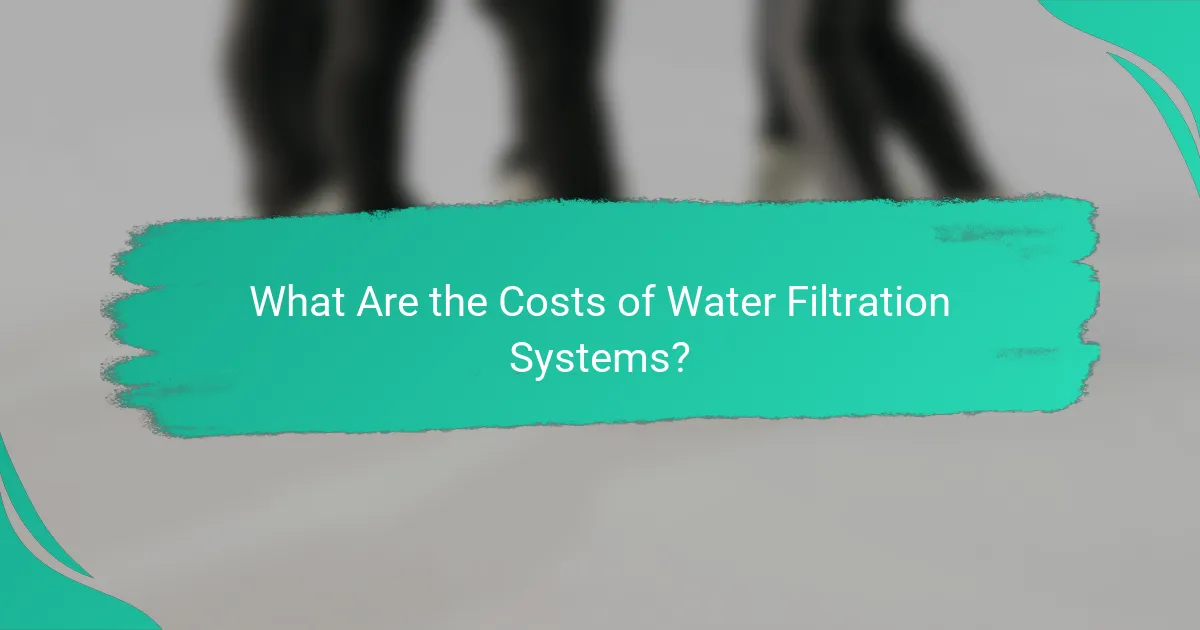
What Are the Costs of Water Filtration Systems?
The costs of water filtration systems can vary widely based on the type, brand, and features. Generally, you should consider the initial purchase price, installation costs, and long-term maintenance expenses to get a complete picture of the financial commitment involved.
Initial Purchase Price
The initial purchase price of water filtration systems typically ranges from a few hundred to several thousand dollars. Basic countertop models may start around $50 to $150, while advanced whole-house systems can exceed $1,000. It’s important to evaluate the filtration technology, such as reverse osmosis or UV purification, as this can significantly impact the price.
When selecting a system, consider the capacity and the specific contaminants it targets. Higher-end models may offer better performance and longer lifespans, which can justify the higher upfront cost.
Installation Costs
Installation costs for water filtration systems can vary based on the complexity of the setup and local labor rates. Simple countertop units may require minimal or no installation fees, while whole-house systems could cost anywhere from $200 to $1,000 for professional installation.
Before proceeding, check if your system requires plumbing modifications or electrical work, as these factors can increase installation expenses. Always obtain multiple quotes from licensed professionals to ensure competitive pricing.
Long-term Maintenance Expenses
Long-term maintenance expenses for water filtration systems include filter replacements, system servicing, and potential repairs. Filter replacements can range from $30 to $200 annually, depending on the type and frequency of use. Some systems may require more frequent changes if they process high volumes of water.
Additionally, consider budgeting for routine maintenance checks, which can help prolong the life of your system. Neglecting maintenance can lead to decreased efficiency and costly repairs down the line, so it’s wise to follow the manufacturer’s recommendations closely.

What Are the Benefits of Using Water Filtration Systems?
Water filtration systems provide cleaner, safer drinking water by removing impurities and contaminants. They enhance the quality of water, leading to improved health and better taste.
Improved Taste and Odor
Water filtration systems significantly enhance the taste and odor of tap water by eliminating chlorine, sediment, and other unpleasant substances. This makes drinking water more enjoyable and encourages better hydration habits.
Many consumers notice a marked difference in flavor after installing a filtration system, as these systems can reduce metallic tastes and odors associated with plumbing. For instance, activated carbon filters are particularly effective at absorbing chlorine and organic compounds that contribute to bad taste.
When selecting a filtration system for taste improvement, consider options like reverse osmosis or multi-stage filters, which can provide comprehensive purification. Regular maintenance is essential to ensure optimal performance and taste, so be sure to follow the manufacturer’s guidelines for filter replacement and system upkeep.
